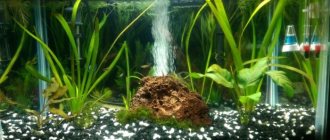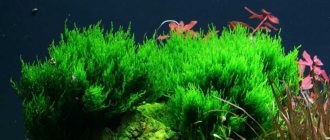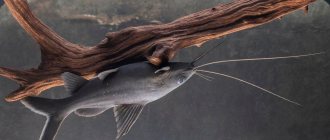Aeration is a special process of saturating water with oxygen molecules. Its essence lies in mixing layers of aquarium water, in which oxygen mixed with air enters through the depth of the water layer. Saturation can occur either from the environment or using a spray. Oxygen can be seen in the water - these are small air bubbles that saturate the aquarium water. When these bubbles come into contact, the water is gradually saturated with oxygen. The number of bubbles directly affects the quality of water saturation. What aeration in an aquarium is will be discussed in more detail in this article.
Aeration in the aquarium
What does oxygen depend on?
There are several factors that can affect the amount of oxygen. This is the temperature, the presence of vegetation and living organisms in the tank . Now let's take a closer look at each of these factors.
Temperature
If the temperature of the water decreases, then the concentration of oxygen in it also decreases. Raising the temperature to a level higher than normal provokes an acceleration of metabolic processes in aquarium inhabitants. This leads to an increase in their need for oxygen. Accordingly, a decrease in temperature leads to the opposite consequences. The situation can be stabilized using aeration .
Aquarium water temperature
Vegetation
The peculiarity of plants lies in their ability to produce oxygen. But here, too, not everything is so simple. It is necessary to understand that at night, using this oxygen, they participate in the process of hydrocarbon production. It turns out that fish breathe oxygen produced by plants during the daytime, and at night they are faced with air deficiency.
Aquafauna
Oxygen concentration can depend not only on plants, but also on living organisms inhabiting the aquarium. First of all, we are talking about snails and other small creatures. The number of these creatures directly affects the amount of organic waste and, accordingly, bacteria, which also consume oxygen. Therefore, aquarium fauna plays an important role in the process of oxygen formation.
Snail in an aquarium
Is there a difference in the appearance of foam in the new and old tank?
The difference in the appearance of foam in an old and new aquarium depends on the nature of its origin.
If the origin is chemical (feed, toxic decorations, medications, algaecides), then there will be no difference.
If the foam is of a biological nature (problems with the filter, loss of biological balance, bacterial outbreaks), then older aquariums are more resistant to such phenomena, since they have a supply of beneficial bacteria and a fully running nitrogen cycle.
In them, foam forms noticeably less often, and if something happens, it passes noticeably faster. The exception is soil acidification. Only old aquariums are susceptible to this phenomenon.
How do you know if the indicator is normal?
Finding out whether aeration is normal in your aquarium is quite easy. In this case, the behavior of the fish is normal and does not cause any suspicion. But in the case of disturbed aeration, aquarium inhabitants behave rather strangely. They begin to rise up to take a breath of air. If such signs are identified, urgent measures must be taken.
If aeration is weak
The optimal oxygen concentration in an aquarium is 5 mg/l. But if the level is significantly lower than normal, then all living creatures in the tank will eventually die from lack of oxygen. There is nothing good about this, so it is necessary to maintain aeration.
Weak aeration is dangerous
If the aeration is too strong
You shouldn’t expect anything good from a very high concentration of oxygen in water either, because such changes cause irreparable harm to aquarium inhabitants. Due to an excess of oxygen, fish may develop gas embolism (air bubbles form in the circulatory system, which leads to death). To avoid sad consequences, it is recommended to avoid oxygen oversaturation. To do this, you do not need to install many compressors for aeration.
Aquarium fish
Foam and bubbles on the surface. What is this?
Tell me, please, what can it be?
I started a 200 liter aquarium, FAN-3, medium-sized bubbles appeared on the surface (the size of a black peppercorn). In total, covering about 60-70% of the water surface. Three days ago I bought and installed a two-channel compressor. For one channel the sprayer is 40 cm long, on the second 10 cm long. So, the very next day, many bubbles larger than a pea appeared on the surface, covering about 80% of the surface, and the remaining 20% was covered with white foam from white bubbles (in the corners aquarium). Please tell me what is this? Maybe this is because the aquarium was launched a week ago? Or is it dangerous? What should I do? Or maybe I need to wait?
Thank you all in advance for your answers!
Is there a film on the surface of the water? From the description it is not very clear what kind of bubbles are and why they do not burst. I assume that a bacterial film has simply formed on the surface and the bubbles remain underneath it. You can remove the film from the surface with newspaper.
Own on Aqa.ru, Advisor
Modified 3.2.06 by shurae
There is no film on the surface of the water. But maybe I just don't see her? What does it look like and how can it be seen through the bubbles?
I washed the soil very carefully and boiled it for 30 minutes. I did not wash the aquarium with any detergents. Only with a wet sponge. Water was poured through a three-stage Geyser filter. Then I used stress zym and stress coat starters. When I turn off all the compressors, the foam disappears in 10-15 minutes, especially if I dribble in the aquarium with my hand. So, if these are substances secreted by microorganisms, then what to do then? Or is this normal and will go away later. After all, my aquarium is only a week old!
Source
Methods of water aeration
There are two ways to provide aeration in an aquarium: natural and artificial. Now let's talk more about each of these methods.
Natural
Natural aeration in the aquarium occurs due to the breeding of snails and the cultivation of various plants. Plants participate in photosynthesis , which produces oxygen. In this case, snails act as an indicator of the amount of oxygen. When the oxygen level is normal, snails live on the rocks or on the bottom of the aquarium, but if the level drops, they move to the walls of the tank or to the leaves of plants growing there.
Natural aeration in the aquarium
Artificial
The essence of this type of aeration is the use of special equipment, for example, a soil filter or compressor.
Two-channel compressor for aquarium
- Compressor. Working continuously, the device sprays oxygen, enriching the aquarium water with it. Some aquarists turn off the compressor at night, but this is strictly not recommended.
- Spray. It is used in conjunction with a compressor. The sprayer is installed on the bottom of the aquarium, where it effectively distributes the oxygen supplied by the compressor throughout the entire aquarium .
- Water pump. A special device, the design of which includes channels for oxygen supply and a filter. If we compare a pump and a compressor in terms of air flow, the first one is undoubtedly the leader.
- Soil filter. In its functions, a filter is very similar to a compressor. He takes part in creating a current in which layers of water begin to move. Due to the fact that the top layer comes into contact with air, oxygen saturation occurs.
Aquarium sprayer
Please note! Hose connectors are also used as a complement to the pump and compressor. They are used to move aeration devices.
Main reasons
Scenery
To solve the problem with decorations you need to:
- Remove the ill-fated object from the water
- Start the filter and aerator.
Sometimes dead aquarium inhabitants can get stuck in the decorations and this can also cause foam to appear.
Filters
filter
- Purchasing a high-quality filter with optimal power if it does not cope with its task.
- Disassemble and wash the filter if it is dirty.
Chemicals and medicines for fish
To get rid of negative effects you need:
- Minimize the amount of chemical fertilizers and medications.
- Use a mechanical filter, pump or aerator.
Plant dissolution
In the event of soil contamination by toxic substances, it is necessary to:
- Remove the soil and boil it thoroughly.
- Dry in the oven.
Feed quality and quantity
- Study each phenotype contained in the aquarium.
- Choose the optimal portion size and appropriate nutrition, and do not go beyond the established limits when feeding.
- Choose quality food.
It is important to ensure that no rotting food appears.
Water quality
High-quality water for an aquarium should be clear and slightly yellowish.
In case of introduction of pathogenic organisms, obvious blooming of the aquarium, soil contamination or fungal mucus, a complete water change will be required.
It is important to remember that a complete water change should only be done in the most urgent cases.
Aeration methods without electricity
There are alternative methods of aeration that do not require electricity. As a rule, they are used when transporting fish. First of all, special oxygen tablets, hydrogen peroxide, are used. Aeration is also carried out through ozonation and a manual compressor. Now let's talk more about each of these methods.
Ozonation
The essence of the method is to supply ozone into water, rather than pure oxygen. Ozonation also helps to get rid of turbidity in aquarium water, as well as disinfect the aquarium. It is important to carry out ozonation before spawning . But before carrying out it is necessary to relocate all living creatures from the aquarium.
Ozonation of water
Oxygen tablets
The use of special oxygen tablets allows you to increase the oxygen level in the aquarium in a short time. One tablet contains about 30 mg of oxygen. This method is effective when transporting fish.
Oxygen tablets
Hydrogen peroxide
Another method of aeration is using hydrogen peroxide. This is a catalyst that breaks down into water and oxygen after contact with aquarium water. In addition, peroxide is harmless to all aquarium inhabitants. The main task of hydrogen peroxide is to resuscitate fish after oxygen starvation. Peroxide is also effective for controlling algae in an aquarium.
Hydrogen peroxide
Manual compressor
Such devices are used primarily when transporting slaves, as well as when selling them. The compressor is powered not by electricity, but by hand pressure. You can make a hand compressor yourself using a regular rubber bladder from a ball. A certain amount of air is pumped there, the supply of which is then regulated by pressing. A bicycle wheel tube may also work.
You can make a manual compressor with your own hands TOP 11 unpretentious aquarium fish TOP 10 largest aquarium fish TOP 20 beautiful aquarium fish TOP 12 most expensive aquarium fish
How to make a compressor yourself
You don’t have to spend money on a compressor, because you can make one yourself. To do this, you need to purchase some elements (motor and power supply). Then it's a matter of technique.
What do you need for work?
To make a compressor for an aquarium, you need to prepare the following tools and materials:
- electric motor;
- a piece of wire;
- a sheet of plywood and several blocks of wood;
- awl;
- hot glue;
- a thin wooden stick (suitable for a lollipop);
- rubber tube with adapter;
- scotch;
- candles;
- plastic cover;
- camera from a ball or bicycle;
- power unit.
First, prepare everything you need.
You also need one balloon for the compressor. Once everything you need is at hand, you can get to work.
Instructions
Below are step-by-step instructions, following which will greatly facilitate the process of manufacturing an aeration compressor.
Step 1. Cut the balloon in half using scissors.
The ball is cut in half
Step 2. Drill two small holes in the plastic cover, 3 and 6 m in diameter. Any rough edges must be sanded to obtain a smooth surface.
Holes are drilled
Step 3. Cut out a horseshoe shape from rubber. Then carefully glue the resulting horseshoe using a glue gun to the drilled lid (to its inner part).
Cut out this part
Step 4: Pull half of the balloon onto the lid. Make sure that the surface of the structure is elastic. Secure the ball with tape and carefully cut off any excess.
Pull half a balloon onto the lid
Step 5. Cut a small triangle from a sheet of plywood. Its dimensions must correspond to the dimensions of the motor. Glue this motor to the plywood. Now make the base for the compressor by making legs from blocks. You should get a small table on which the motor and power supply are located.
Motor based
Step 6. Make an eccentric by shortening the hot glue stick, cutting off 6-8 mm. Then make a hole on the side and top using a regular awl. Pass the wire through the side hole. Install the finished eccentric on the motor shaft.
A hole is made with an awl
Step 7. Shorten the wooden lollipop stick to 4cm and glue it to the candle holder. Then this structure must be attached to the eccentric. The other end of the stick must be glued to a plastic lid with a ball in the center. The lid itself must be attached to the plywood using the same glue.
Stick attachment
Step 8. Make a small hole for the lid with the ball and fix the adapter in it. A rubber tube must be attached to this adapter. That's all. aeration compressor is ready to use!
Homemade compressor for aeration











